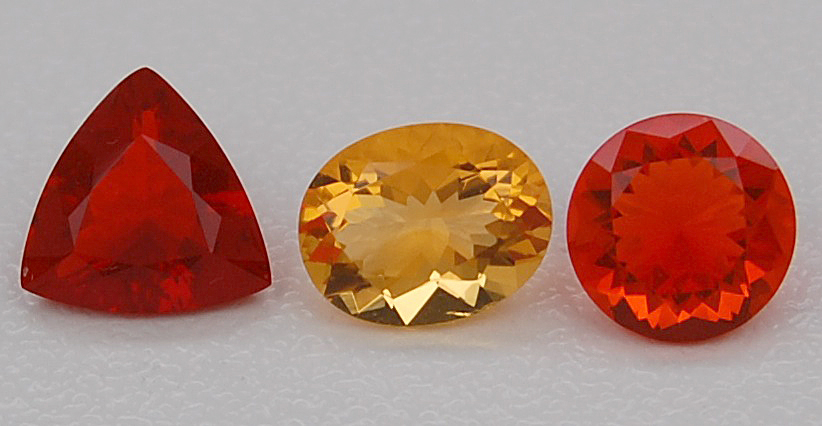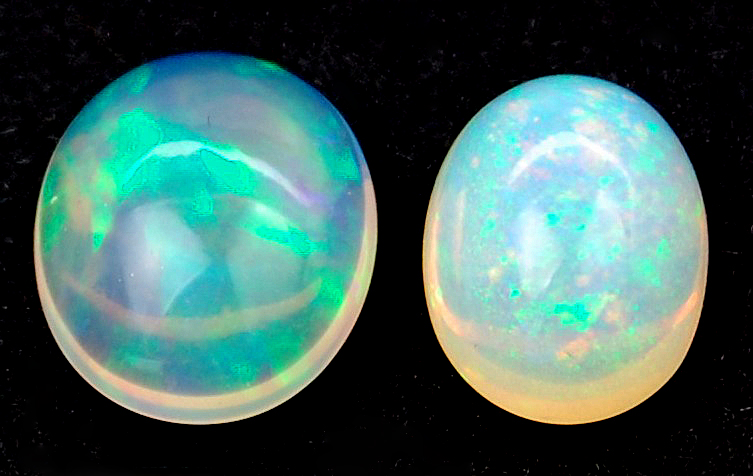

Introduction: Opal is a mineral species with an amorphous structure. Opal has the ability to form as a pseudomorph replacing another mineral or substance taking on the outward appearance of the item it replaces. Some examples are clam shells, snail shells, bones and tree branches. Fire opals are pictured above left, from left to right, 1.26 ct red trillion, 1.25 ct yellow oval and 1.20 ct orange round. The crystal opal cabochons pictured above right, are 3.28 ct displaying harlequin play of color and 3.25 ct showing pinfire play of color.
Colors: Opal can be transparent to opaque of virtually any body color. Varieties and trade names are numerous but the most common are:
-White Opal: translucent to semi-translucent opal with a play of color against a white body color.
-Black Opal: translucent to opaque opal with play of color against a black, grey, blue, green or brown body color.
-Crystal Opal: transparent to semi-transparent gem opal with a colorless body color and play of color.
-Fire Opal: transparent to semi-transparent opal with yellow, red, orange or brown body color with or without play of color.
-Jelly Opal: colorless, transparent to semi-transparent with no play of color.
-Contra-luz Opal: transparent opal with play of color seen when light is transmitted through the stone. Play of color can also be seen in reflected light.
-Boulder Opal: is an opal seam, often very thin, naturally attached to the sandstone matrix where it formed and exhibiting a strong play of color.
-Hydrophane: is an opal that appears as common opal (translucent to opaque opal with no play of color) when dry but develops play of color when immersed in liquid.
Some of the names associated with play of color are:
-Pinfire: small, close set pinpoints of color
-Harlequin or Mosaic: broad, angular, close set patches of color
-Flash: play of color that shows in sudden flashes that appear and disappear as the stone is moved.
-Peacock: play of color that is mostly blue and green
Clarity: Opal is not classified by clarity type as other transparent gems. Inclusions would be unusual in most gem opals and any imperfections would mostly be cut away unless the inclusion did not interfere with the overall look of the stone.
Stone Sizes: Like diamond, ruby, sapphire and emerald, many of the large opals are given names such as the Roebling Opal at the Smithsonian, weighing in at approximately 500 grams. Most opals used in jewelry rarely exceed 15 carats.
Localities:
-Australia: best known locality for opal, the first discoveries around 1850. Australia is the source of well over half of the world’s supply. Lightning Ridge, Coober Pedy and Andamooka are all well established localities.
-Ethiopia, Brazil, Kenya, Mexico
-United States: Virgin Valley, Nevada, Idaho and Oregon
Treatments:
Opal may be impregnated with oils, wax or plastic to stabilize and/or improve the play of color. It is also possible to be sugar treated followed by an acid bath to carbonize the sugar and produce a darker body color. Dyeing, foil backing as well as black paint backing are also done to improve the play of color.
Gemology:
-Refractive Index: 1.450 (+0.020, -0.080). Fire opal may read as low as 1.37 but generally between 1.42 to 1.43.
-Birefringence: None
-Optic Character: Singly refractive, anomalous double refraction common due to strain
-Specific Gravity: 2.15 (+0.08, -0.90)
-Hardness: 5 to 6.5
-Toughness: very poor to fair
-Chemical Composition: SiO2 with 3 to10% water content by weight
-Cause of Color: Play of color is caused by a diffraction effect from light passing through tiny, regularly stacked silica spheres.
-Fluorescence:
black or white body color - inert to white to moderate light blue, green or yellow in LW and SW
fire opal - inert to moderate greenish brown in LW and SW
phosphorescence possible in all opals
-Cleavage: None
-Phenomena: Play of color, chatoyancy (uncommon) and asterism (rare)
Name: Opalus was the ancient Latin name for the gem, probably derived from the Sanskrit upala, meaning precious stone. The Greek opallios literally means “to see a change of color”.
Dates: Opal is the birthstone for the month of October and to commemorate the 14th anniversary.
Care: The ultrasonic and steamer should never be used. Warm, soapy water is safe if done quickly. Because of the porous nature of opal, soapy water can be absorbed and dull or eliminate the play of color.
To see available opal, click here.
